Abstract
This study aimed to assess the potential operational implications of integrating Advanced Air Mobility (AAM) traffic at the Orlando International Airport (MCO) Class Bravo airspace. Researchers developed corridor prototypes within MCO’s airspace to analyze potential traffic conflicts and wake turbulence risks between MCO’s commercial and AAM traffic. Furthermore, an AAM ecosystem at MCO was developed to enable the simultaneous integration of realistic MCO and AAM traffic paths. The ecosystem was created on a series of operational assumptions derived from the FAA’s AAM implementation plans and concepts of operation. The findings of this study revealed that the AAM ecosystem (corridor designs and operational schedule) had little to no impact on existing commercial air traffic operations based on the assumptions made for this analysis. Additionally, the assessment revealed that integrating 22 aircraft/airframes could result in an efficient operational infrastructure with no traffic or wake turbulence conflicts with existing commercial air traffic at MCO. This groundbreaking study marks one of the initial evaluations of AAM integration at a major international airport in the United States.
1. Introduction
The air transportation industry has long been characterized by the development of dependable, secure, and reputable travel alternatives. In recent years, a new emerging concept within this sector has been known as Advanced Air Mobility (AAM). AAM is a transforming air travel alternative envisioned to transport people or goods in urban and regional areas. The Federal Aviation Administration (FAA) defines AAM as an emerging aviation ecosystem incorporating innovative technologies and aircraft designs to support sustainable, efficient, and equitable air transportation opportunities [1]. The revolutionary AAM concept envisions aircraft with advanced technologies, electric aircraft, and aircraft capable of vertical takeoff and landing (eVTOL) in controlled and uncontrolled airspace operations. Nevertheless, assessing the implications and responsibilities of implementing such an innovative concept on the current air transportation infrastructure is paramount due to its significant impact on the safety of the traveling public.
The AAM concept is an initiative by the FAA and the National Aeronautics and Space Administration (NASA) to revolutionize air transportation. This groundbreaking concept uses innovative technologies and aircraft designs to provide an alternative transportation system for urban, regional, and intraregional locations for underserved locations in the existing air transportation industry. In June 2020, the FAA released the first version of the Urban Air Mobility (UAM) Concept of Operations, marking an essential phase in the AAM implementation. Later, in April 2023, a second version of the UAM Concept of Operation was released, providing new development and details on early operational concepts of AAM vehicles in urban environments. By July 2023, the first AAM implementation plan was introduced, outlining important operational aspects. Overall, the concepts of operations and implementation plans outline the operational framework for AAM development, ensuring the highest safety standards.
The air transportation industry faces a significant challenge as it seeks to integrate AAM operations into the existing airspace infrastructure. The traditional airspace management infrastructure, primarily designed for conventional aircraft, must strategize the integration of a diverse range of new vehicles, each with unique operational characteristics. The AAM integration demands a meticulous approach to developing efficient air traffic management processes, clear regulatory frameworks, and advanced airspace operations and, most importantly, maintaining the safety of air transportation infrastructure.
This research assesses the potential integration of AAM vehicles, emphasizing their possible impact on current operations at Orlando International Airport (MCO) in Orlando, Florida. The study represents a significant milestone as it is one of the first assessments of AAM integration at a major international airport. The Embry-Riddle Aeronautical University research team, sponsored by the Greater Orlando Aviation Authority, was tasked with developing potential AAM corridor alternatives and evaluating the implications of AAM operations within MCO’s Class Bravo airspace. The primary objective of this study was to assess traffic conflicts and wake turbulence considerations between existing MCO commercial air traffic and AAM vehicles and provide operational guidelines for integrating AAM operations at MCO.
2. Literature Review
While AAM concepts and developments promise a futuristic approach and alternative to air transportation, it is essential to carefully evaluate the operational considerations required for their safe implementation within the National Airspace System (NAS). Emerging technologies and the potential advantages of small vertical takeoff and landing vehicles operating below 4000 feet could transform local and regional transportation options. The literature highlights the significance of assessing AAM and its operational implications, addressing the challenges of such integration and the need for systematic assessments. A successful implementation of AAM relies on evaluating the operational parameters necessary to ensure a reliable, efficient, and safe infrastructure.
2.1. AAM Operational Implications
The operational implications of AAM are anticipated to be substantial. In the early years of AAM operational implementation, airport shuttles and air taxis are expected to serve 82,000 passengers across the United States daily, with approximately 4000 AAM vehicles [2]. An estimated 55,000 daily trips are projected, along with an annual market capitalization of 2.5 billion USD [2]. The operational implications were estimated by extrapolating the combined demand for air taxis and airport shuttles across all 486 urban areas in the U.S. [2]. Despite the demand for traditional commercial aviation, AAM is expected to surpass conventional air travel [3]. Urban Air Mobility (UAM), a sub-term of AAM focused on urban settings, is also forecasted to increase demand for air mobility services in urban environments [4]. As demand for AAM services grows in metropolitan and regional areas, the existing air transportation infrastructure will be challenged to determine if it can accommodate the exponential growth within aviation transportation.
Although the development of AAM vehicles offers numerous opportunities across various sectors of society [5], AAM integration requires a meticulous approach, particularly in AAM air traffic management. The Florida Department of Transportation (FDOT) considers early compatibility planning a fundamental step in ensuring that AAM traffic is not adversely affecting the existing airport system’s capacity to meet traditional aviation demands and requirements [6]. The FDOT anticipates an increased demand for air traffic controllers during the mature high-tempo phase of AAM [6]. Similarly, in its first AAM Implementation Plan [1], the FAA stated that the development and design of AAM routes should not disrupt or affect existing Air Traffic Control (ATC) flow management [1]. Given the emphasis by government agencies on minimizing the impact of existing ATC operations, only a few studies have addressed the practical operational implications of AAM. Existing literature has focused primarily on vehicle development, with limited attention given to how AAM vehicles interact with existing air traffic [3]. Furthermore, there has been only limited practical implementation and real-world scenarios of AAM integration, as well as risk management practices and safety [5]. This gap highlights a deficiency in real-world applications and operational scenarios when evaluating the operational impact of AAM. Despite the projected demand and implementation of AAM, numerous other challenges remain to be addressed.
2.2. Challenges
Introducing AAM traffic into the existing NAS infrastructure exposes a series of challenges. In an urban setting, UAM development could be influenced by challenges regarding safety, environmental impact, community acceptance, noise, limited UAM infrastructure, and airspace management [7]. To effectively address these challenges, stakeholders must develop policies and regulations that adhere to safety and operational standards [7]. A recent study, which collected insights from 32 key stakeholders worldwide, underscores the importance of legal and regulatory frameworks in the early developmental phase of UAM [8]. According to [5], regulatory and policy advancements are essential, along with a resilient and reliable air traffic management system, thoughtful urban planning, and the establishment of public trust. Additionally, according to [9], multiple concepts of operations have consistently highlighted a series of challenges in AAM, such as aircraft development, air traffic management, battery technology, competition and social mobility, cybersecurity, and safety-critical risks. Multiple aircraft designs with many performance characteristics have been introduced, even in the early years of the AAM concept. In [10], various aircraft variations were presented along with their performance characteristics, further highlighting the dynamic and complex nature of air traffic flow analysis. Consequently, overcoming the challenges associated with AAM integration will require a multifaceted approach consisting of regulatory frameworks, advanced air traffic management, urban planning, and an effort to gain public trust.
Traditionally, aviation has been predominantly limited to airports and adjacent areas, with minimal operations in urban and suburban settings. The integration of AAM aims to enhance connectivity between aviation infrastructure and operations in underserved regions and communities within local areas and in proximity to major international airports. Although connecting underserved areas and cities offers substantial benefits, AAM traffic could disrupt air traffic operations at nearby airports. Studies have identified a lack of air traffic management assessments and understanding regarding the impact on current air traffic operations despite the potential implications to adjacent airports [3,5]. For instance, FDOT advocates coordination with local airport authorities to address essential aspects such as vertiport location, wake turbulence separation standards, and departure and approach paths [6]. Consequently, airport authorities are urged to thoroughly evaluate their airspace to identify opportunities for AAM’s legal and safe integration and to develop strategies to mitigate any substantial impact on their existing operations.
2.3. Corridor Development
The development of corridors for AAM represents a crucial area of research, particularly in integrating AAM vehicles into the existing NAS infrastructure. Effective corridor development requires collaborative efforts among academia, industry engineers, and regulators to establish robust safety standards and ensure seamless integration [11]. During early compatibility planning, assessing wake turbulence separation standards and developing corridors to and from the vertiports are critical considerations [6]. Well-planned corridors could increase operational tempo [12] and airspace capacity by up to 10% [13]. The literature highlights the need to evaluate the practical application of route planning, flight altitudes, and ground infrastructure in urban areas [5]. Furthermore, the anticipated scale of AAM operations could potentially increase demands on air traffic controllers, requiring efficient traffic management protocols to address the growing number of vehicles and alleviate congestion [3]. In another study, Ref. [14] developed an analytical framework to evaluate the configuration strategies of the airspace in an urban environment, highlighting the need to consider altitude selection, airspace distribution, and adaptable airspace management. Therefore, systematic planning and research are priorities in effectively addressing the operational and safety challenges associated with AAM corridor development and infrastructure.
2.4. Implementation Plans and Concepts of Operations
The FAA’s implementation plan adopts a crawl-walk-run methodology that acknowledges potential implementation opportunities while minimizing the operational impact on the existing infrastructure. Similarly, the UAM concept of operations also describes a gradual approach and implementation of UAM vehicles by establishing three operational stages: initial, midterm, and mature. The initial phase includes the integration of AAM traffic leveraging current rules and regulations with no concepts of operations. During this phase, operators might be required to address operational needs through letters of agreement (LOAs). Pilots will be expected to be onboard. In the midterm phase, there is the expectation for the operational tempo to increase and evolve through changes to existing governing rules, concepts of operations, infrastructure, and technology. Predominantly, the pilot will be on board the aircraft, but remote pilot operations will be introduced. Lastly, the operational tempo is expected to grow significantly in the mature stage. In addition, the mature stage will expect a complex AAM infrastructure and network. Automation enhancements could enable remote pilot operations to match the level of implementation and pace of AAM piloted operations [12]. This elaborate evolution requires the collaboration of government agencies, inter-agency working groups, operators and manufacturers, infrastructure providers, and the public [1]. Although integrating AAM is a complex and challenging task, the FAA has emphasized that its top priority is the safety of the traveling public [1].
2.5. Innovate 28
Innovate 28 (I28) refers to the FAA’s initiative to integrate AAM operations in one or multiple locations in the United States by the year 2028. I28 will mark an important milestone in AAM integration across the NAS [1]. The I28 milestone represents a significant advancement in fostering collaboration among industry stakeholders to facilitate continuous integration of future AAM operations and evaluating future operational needs. In other words, I28 serves as a benchmark for the continuous development of AAM operations. Considering that aircraft are undergoing certification and that aircraft performance or operational needs are not clearly defined, the concepts described in the 2023 FAA’s implementation plan were developed based on several assumptions. For example, according to the AAM Implementation Plan [1], aircraft are expected to be certified under Title 14 of the Code of Federal Regulations (CFR) 21.17(b). The aircraft will operate under Part 135, piloted operations with authorization to transport passengers and cargo. Regarding airspace and route structure, the aircraft are expected to operate below 4000 feet above ground level in urban and metropolitan areas and in and around Class Bravo and Charlie airspace. The FAA demands that AAM operators comply with current airspace visibility and equipment requirements to legally operate in Visual Flight Rules (VFR) and Visual Meteorological Conditions (VMC) within the operating airspace.
3. Methods
The study aimed to assess the potential operational impact of traffic conflicts and wake turbulence encounters on existing MCO commercial traffic operations while implementing AAM vehicles in and around MCO’s Class Bravo airspace. During the initial development phase, the Greater Orlando Aviation Authority (GOAA) team collaborated with the researchers to outline three key essential aspects of the study: the potential dates of the analysis, north or south air traffic operations, and GOAA’s corridor location preference. Researchers were interested in analyzing one of the previous year’s busiest days for capacity and validity purposes. One of the busiest days at MCO happened during Spring Break of 2023. GOAA also stated that south operations (south takeoffs and landings) were more frequent than north operations (north takeoffs and landings). Therefore, researchers selected 25 March 2023 for the assessment. Real-time air traffic historical data for 25 March 2023 was reproduced on TAAM and Google Earth Pro (7.3.6.10201 (64-bit)) to be analyzed. Lastly, corridor prototype development was further developed on feedback gathered and provided by GOAA.
3.1. Software—Total Airspace and Airport Modeler (TAAM)
The integration of the AAM vehicles into MCO’s airspace and their impact was assessed using a 4D (3D plus time) fast-time simulation software (TAAM_2023_2_0_Release_22), Total Airspace and Airport Modeler (TAAM), developed by Jeppesen. TAAM is an accurate, gate-to-gate, high-quality software designed to assess the operational impact of airports and airspace operations [15]. It allows its users to accurately predict the effect of unlimited present and future implications on airspace and airport designs. TAAM can simulate real-world air traffic scenarios by replicating existing and redesigned airspace, flight schedules, aircraft paths, conflict resolutions, wake turbulence, airspace and airport ground operations, capacity management, airspace utilization, and many others. Furthermore, it could even simulate real-world environments by introducing variables affecting schedules and ATC instructions requiring air traffic flow adjustments (placing airplanes in holding patterns, slowing airplanes down to maintain separation, go-arounds, etc.), proving a more realistic, highly validated assessment of airspace operations and its implications [15].
3.2. Research Site
The Orlando International Airport (MCO) is one of the largest commercial airports in the United States, influencing domestic and international air travel. It connects to the region’s top attractions, including Disney theme parks and many other world-class destinations, attracting millions of tourists annually. With approximately 58 million passengers traveling through each year, MCO ranks among the busiest airports in the country. It is a crucial link to Central Florida, fueling the region’s thriving tourism industry and facilitating connections critical to business and trade.
The Orlando International Airport manages over 350,000 aircraft operations annually, including a complex network of commercial flights, general aviation, and cargo. The airport has four main runways, three major passenger terminals, and facilities to transfer, process, and store cargo [16]. These facilities are distributed across 11,600 acres in Central Florida, supporting the airport’s infrastructure to accommodate high traffic volumes while maintaining operational efficiency. GOAA is dedicated to ensuring the safe and efficient use of airport facilities, providing reasonable and nondiscriminatory access to all aeronautical users. Additionally, the Orlando International Airport substantially influences Central Florida’s economic impact by contributing $41 billion annually to the regional economy [16]. The financial impact highlights MCO’s crucial role as a primary driver of economic growth, profoundly influencing tourism, transportation, and logistics.
In addition to the local economic impact, the airport employs people with various expertise, including professionals in finance, operations, construction, engineering, public affairs, customer service, concessions, and many others. As a significant employment hub in Central Florida, MCO generates substantial direct and indirect employment opportunities, fostering economic stability and stimulating regional growth.
The proposed vertiport is projected to be in the periphery of the airfield, specifically on the northeast side of the field next to runway 17 L (see Figure 1). It is expected to be independent of MCO’s runways, providing a flexible path to AAM corridor designs. GOAA expects one vertiport with one final approach and takeoff area (FATO) capable of handling electric vertical takeoff and landing (eVTOL) vehicles.
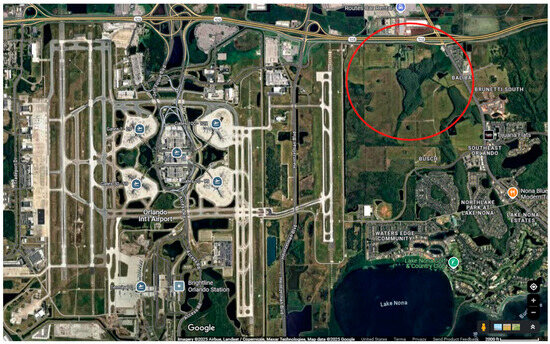
Figure 1.
Proposed vertiport location highlighted in red circle.
3.3. Prototype Corridor Development
In accordance with the FAA’s Innovate 28 implementation plan [1], which aims to gradually introduce AAM air traffic into the existing infrastructure with minimal to no interruption to existing operations, prototypes were initially conceptualized to transition AAM vehicles around MCO and the Orlando Executive Airport (ORL) with minimal impact on existing air operations. The GOAA team, however, raised legitimate concerns that the designation of corridors around and between MCO and ORL could conflict with departures and arrivals. Furthermore, the factors of time and distance were also legitimate considerations. GOAA emphasizes the significance of travel time in future passenger operations. Therefore, circumnavigating MCO further north or south could lead to more travel time and a less desirable transportation alternative. Consequently, GOAA members proposed overflying MCO to minimize travel time and provide a more direct alternative rather than circumnavigating around MCO. In the absence of direct interaction with MCO controllers, a series of assumptions were required during corridor development. To gain insights into traditional air traffic control operations, researchers sought advice from faculty members with substantial experience as air traffic controllers. Informal discussions with faculty members were held during the development phase of the corridors to gather valuable feedback on potential paths and altitudes. Before finalizing a specific corridor design, researchers consulted faculty members regarding the feasibility of the proposed corridors (prototypes), altitude selection, and alignment with operational traffic management guidelines. Special attention was given to the air traffic operational guidelines regarding MCO commercial traffic go-arounds and the transition altitude when aircraft are resequenced for another approach and landing, as AAM traffic is expected to be overflying the airfield. Recommendations for minimal transition altitude over MCO were incorporated concerning the transition altitude at the airport, ensuring adequate clearance between an AAM aircraft and MCO commercial traffic following a go-around.
A series of different prototypes were developed. Those prototypes were driven by existing air traffic control operations, with the primary objective of avoiding traffic and wake turbulence conflicts. Two prototypes, labeled as prototypes two and three, were selected after considering all the information provided to researchers. The altitude selection, design, and development are aligned with the FAA’s AAM Implementation Plan [1], Airspace Usage and Route Structure section. This implementation plan anticipates AAM aircraft operating up to 4000 feet above ground level in urban and metropolitan areas, in close proximity to airports, including operations in Class Bravo and Charlie airspace.
The dynamic nature of operational implications and concepts of operations makes the development process quite complex. Acknowledging that AAM operations and concepts are dynamic is crucial during the development of future corridor designs. In this study, multiple factors significantly influenced the design, altitude selection, and developmental process. First, the researchers evaluated MCO’s existing commercial operational environment, including traffic flow, departure/arrival procedures, and approaches. In addition to identifying potential opportunities for airspace utilization, researchers considered GOAA’s recommendations, including an analysis of overflying the airfield. Based on the current commercial air traffic flow and GOAA’s suggestions, the development of the prototypes was grounded in the operational guidelines outlined in the FAA’s implementation plan and the concept of operations, along with informal discussions and feedback from ATC faculty members regarding which prototype was more effective and why. Researchers identified two potential prototypes aligned with the previously mentioned considerations (traffic flow, go-around procedures, departure/arrival paths, etc.). We conducted a series of test runs in TAAM and adjusted the corridors to enhance the corridor design. In addition, researchers evaluated the in-trail separation by considering a separation of any amount of time between 5 and 30 min between AAM aircraft. This approach allowed researchers to assess the ecosystem’s traffic conflicts (between AAM/AAM and AAM/MCO commercial traffic), delays, and throughput.
3.3.1. Prototype 2
Prototype 2, see Figure 2 and Figure 3, was developed over the MCO airport. This design prioritizes safety by providing a corridor over the airport to minimize the impact of existing airport operations while at the same time providing a more direct transition from one side of the airport to the other. The prototype was developed after evaluating the airspace by looking at MCO’s departure and arrival procedures and actual flight paths reproduced on Google Earth Pro. The researchers aimed to fulfill the GOAA’s recommendation by creating a corridor over the MCO airport and establishing a more direct connection from the vertiport to the destination.
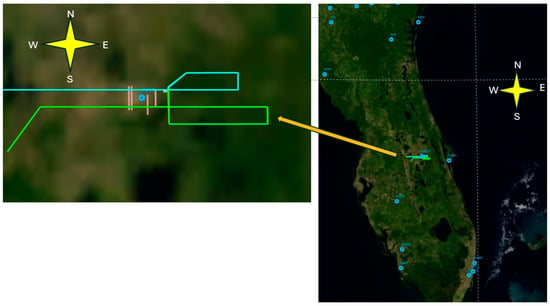
Figure 2.
Prototype 2—top view of the arriving and departing corridors.
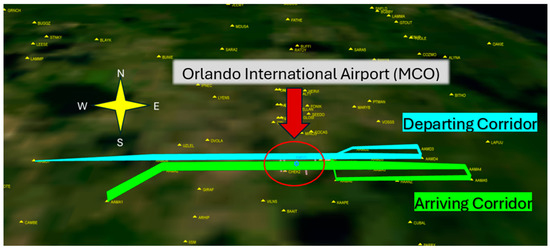
Figure 3.
Prototype 2—3D view arriving and departing corridors.
Prototype 2 consisted of two independent departing and arriving corridors. The departing corridor, depicted as cyan blue in Figure 2 and Figure 3, directs the AAM vehicle from the vertiport to an initial northeast direction. This is followed by a rectangular pattern extending east of the field before transitioning the AAM vehicle over the MCO airport at an altitude suitable and safe for crossing MCO’s departing and arriving commercial traffic. The primary reason for the easterly rectangular pattern is the assumption that eVTOL aircraft performance will require forward acceleration shortly after its vertical takeoff and perform as a conventional airplane throughout the rest of the flight. The departure corridor’s transition altitude was determined to be 2500 feet above ground level. On the other hand, the arrival corridor, depicted as green in Figure 2 and Figure 3, directs the AAM traffic over the southern side of MCO and into an easterly rectangular pattern. The easterly rectangular pattern is designed to provide a path for airplanes to descend. Again, the assumption is that eVTOL vehicles will only depart and land vertically but perform as airplanes in cruise flight. The transition altitude on the arrival corridor is expected to be 3500 feet above ground level.
3.3.2. Prototype Three
The second prototype, labeled prototype 3 (Figure 4 and Figure 5), has a departing path directly over the center of MCO and an arrival corridor over the center of Kissimmee (ISM) airport. This design prioritizes safety and efficiency by providing a departing corridor over the airport and an arrival corridor around MCO to minimize the impact of existing airport operations. The departing corridor, shown in cyan blue in Figure 4 and Figure 5, guides the AAM vehicle from the vertiport in an initial northeast direction. This path follows a rectangular pattern east of the field, allowing the AAM vehicle to climb 2500 feet above ground level. Then, the traffic will maneuver over MCO airport at a safe altitude to navigate over the departing and arriving commercial traffic. The departure corridor was developed to transition at 2500 feet above ground level. The arrival corridor, depicted as orange in Figure 4 and Figure 5, guides the AAM traffic over the Kissimmee airport at 1600 feet above ground level before crossing under the MCO’s departure traffic at 1000 feet above ground level. The traffic continues 1000 feet above ground level until its final descent to the vertiport.
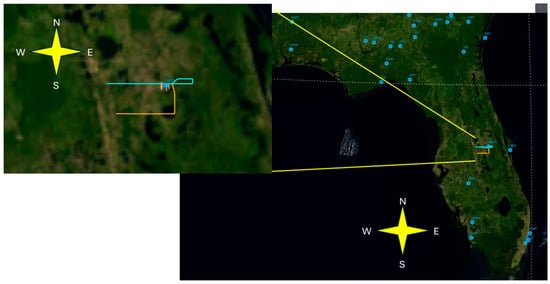
Figure 4.
Prototype 3—top view of the arriving and departing corridors.
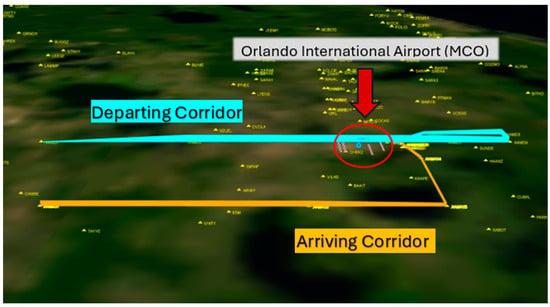
Figure 5.
Prototype 3—3D view arriving and departing corridors.
3.4. Assumptions
In recent years, implementation plans and concepts of operations have been developed to provide a standard frame of reference to support stakeholders’ understanding of different aspects of AAM integration [1,10]. Nevertheless, considering that several factors of AAM are still under development and undefined, researchers were required to develop a series of operational assumptions to provide a realistic operational environment. As a result, researchers made assumptions on aircraft performance, air traffic management, vertiport infrastructure, AAM vehicle operational guidelines, and operational schedules.
The researchers had very limited data on AAM aircraft performance. One AAM manufacturer provided limited aircraft performance data used in this study, which was limited to takeoff/cruise/landing transition phases, cruise speed, and an estimate of the rate of climb and descent. Regarding air traffic management, researchers made assumptions on altitudes, corridor location, and preferences after receiving feedback from former air traffic controllers. Prototypes (vertical and horizontal parameters) were shaped by the feasibility of the actual air traffic management protocol provided by faculty members. Another assumption was the vertiport infrastructure and operational constraints. Although TAAM has the ability to assess operational implications on ground/taxi operations, this study did not focus on ground operations. Instead, it focused on a vertiport design that would accommodate one or two FATOs, where aircraft were expected to take off and land in the same area (FATO) with no taxiing operations.
3.5. MCO Commercial Traffic and AAM Ecosystem
The study aimed to evaluate the operational impact of AAM integration into Class Bravo airspace at the MCO airport, particularly emphasizing wake turbulence and traffic conflicts. In addition to analyzing corridors and their operational impact concerning wake turbulence and traffic conflicts, researchers developed a realistic what-if AAM ecosystem at MCO. The ecosystem consists of one and two FATOs, an operational schedule with flights from 7 AM until 7 PM, and an 8 min to 15 min separation between aircraft, all integrated with existing MCO commercial traffic. The analysis intended to replicate daily operational interaction on 25 March 2023 between existing commercial traffic and AAM vehicles while evaluating the operational impact of both operations.
The development of the AAM ecosystem was fundamentally based on existing operational guidance from the FAA’s implementation plans and concept of operations. Unfortunately, as the AAM concept is constantly evolving and in its early stages of development, researchers were required to formulate a series of assumptions. For instance, limited information was collected on aircraft performance. A general assumption of eVTOL aircraft performance is that the vehicles will only take off and land vertically with no expectation of hovering for climbs and descents. In addition, AAM aircraft are conceptualized to transition to cruise flight shortly after departure. During the rest of the flight, the vehicle is expected to cruise around 85–100 knots and have a climb/descent performance of around 300 fpm. Therefore, corridor development was greatly influenced by the assumptions made about aircraft performance.
The AAM ecosystem also incorporated a series of operational assumptions. The vertiport design and infrastructure were not part of the assessment, but an assumption was made that vehicles would have one or two FATOs. Additionally, the AAM ecosystem assumed that vehicles would depart and land the FATOs within 8 min or 15 min intervals. The 8 min or 15 min intervals are intended to assess the impact of quick turnaround operations, considering that a shorter interval between vehicles could lead to traffic and separation conflicts among AAM aircraft.
The operational rules and weather of the AAM ecosystem and MCO commercial traffic were conceptualized to operate in visual meteorological conditions (VMC) and visual flight rules (VFR). MCO’s commercial air traffic flow conducted southbound departures and arrivals throughout the day at MCO on 25 March 2023. Southbound operations were specifically chosen for the assessment because GOAA members indicated that they occur more frequently throughout the year than northbound operations. The AAM ecosystem incorporated a series of assumptions aligned with industry recommendations and operational guidelines.
A four-way analysis of variance (ANOVA) was used to evaluate the operational impact of the AAM ecosystem and analyze the statistical significance between the number of FATOs, aircraft separation (8 vs. 15 min), and the two different prototypes on departure and arrival delay time in minutes.
3.6. Limitations
This research study is subject to multiple limitations. First, the assessment was limited to one of the busiest commercial airports in the United States and the busiest day of 2023 (25 March 2023). Focusing on the operational impact on a specific day restricts the ability to assess abnormal procedures and factors that may not be relevant during this time of year. This study did not analyze other operations, such as go-arounds, north departures and arrival operations, and inclement weather. Lastly, the absence of emergencies (commercial aviation and AAM) in the assessment restricts the study, potentially overlooking critical factors that could influence air traffic management and safety. Therefore, it is essential to consider these limitations when analyzing the findings and implications of the study.
4. Results
Data from 6618 flights were analyzed in a four-way ANOVA to identify the effect of the four independent variables on the dependent variable (delay time) and determine any significant interactions between the variables. Two four-way analyses of variances (ANOVAs), one for departure delay time and one for arrival delay time, were conducted to compare the effects of the modeled scenarios. The dependent factors were departure and arrival delay time measured in minutes, with a zero-minute delay indicating an on-time flight. The four independent factors compared were as follows:
- The different simulation models—prototype 2 and prototype 3;
- The number of aircraft departing or arriving—20, 22, or 24;
- The number of minutes between arrivals—8 min or 15 min;
- The number of FATOs—1 or 2.
Note that for this analysis, departure and arrival delays are being treated as independent factors, meaning that an arrival delay does not impact a departure delay and vice versa. Additionally, the data being used in an ANOVA are expected to be normal and homogeneous in variance across the groups. Due to the nature of these data, with the ideal condition of zero delay, the data were skewed to the left, and the standard deviations varied between the groups. This was expected to occur as delay time will increase with increased operations. With the large sample size and the nature of the data, the researchers deemed it acceptable for the ANOVA analysis to continue.
The means and standard deviations for departure and arrival delay were as follows (Table 1, Table 2, Table 3 and Table 4):

Table 1.
Departure Delay.

Table 2.
Arrival Delay.

Table 3.
Departure Delay.

Table 4.
Arrival Delay.
4.1. ANOVA #1—Departure Delay
The ANOVA for departure delay revealed a significant main effect for all four independent variables. See Table 5.

Table 5.
Anova #1—Departure Delay.
While the difference in delay time, in minutes, was significant for prototype number and minutes between arrivals, the effect size (η2) on departure delay time was very low. However, the number of FATOs and aircraft departing has a larger effect size, indicating a more significant difference in mean departure delay. The data suggest that having two FATOs instead of one will significantly reduce departure delays. Figure 6 shows the mean departure delay for each prototype with one FATO and two FATOs.
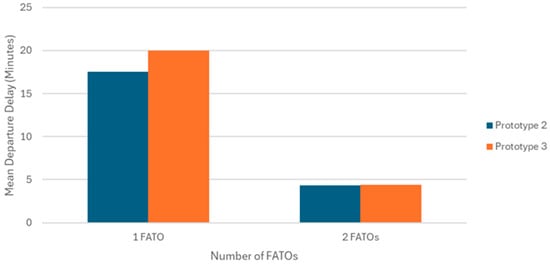
Figure 6.
Mean departure delay vs. number of FATOs.
Additionally, the number of aircraft departing impacts departure delay time. A Tukey post-hoc comparison of the number of aircraft indicated that departure delay time increases significantly as the number of aircraft increases. Increasing from 20 to 22 arrivals increased departure delay times by 6 min, increasing from 22 to 24 increased departure delay time by 7 min, and going from 20 directly to 24 arrivals increased departure delay time by 13 min.
Looking further at departure delay and number of aircraft, the data show a significant two-way interaction between the number of FATOs and the number of arrivals, F(1, 6594) = 233.855, p < 0.001, η2 = 0.064. The graph below, Figure 7, showsthat with one FATO, the delay increases as the number of arrivals increases. However, two FATOs can handle the increased traffic with a minimal increase in delay time.
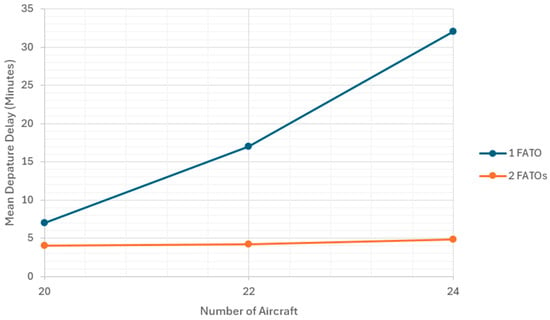
Figure 7.
Mean departure delay vs. number of aircraft.
There was a significant three-way interaction between the number of FATOs, the number of arrivals, and the minutes between arrivals: F(1, 6594) = 6.417, p = 0.011, η2 = 0.001. This indicates that a relationship exists between the three variables; however, the effect is small. Figure 8 highlights how departure delay increases with one FATO; however, with two FATOs, departure delay does not increase regardless of which prototype or time between departure changes.
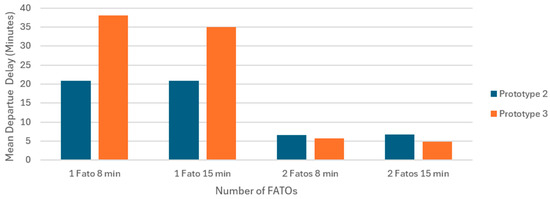
Figure 8.
Mean departure delay at different separation times vs. number of FATOs.
4.2. ANOVA #2—Arrival Delay
The ANOVA for arrival delay revealed a significant main effect for three of the four independent variables. See Table 6:

Table 6.
Anova #2—Arrival Delay.
The number of minutes between arrivals had no significant effect on mean arrival delay. However, the prototype number had a significant effect on delay time with a moderate effect size. This indicates that using prototype 2 instead of prototype 3 will result in lower mean arrival delay times.
Additionally, the number of aircraft departing impacts arrival delay time. A Tukey post hoc comparison of the number of arrivals indicated that arrival delay time increases significantly. The increase in the number of arrivals from 20 to 22 led to a 6 min increase in arrival delay time. The increase from 22 to 24 arrivals resulted in a 6 min increase. The total increase in delay time from 20 to 24 arrivals was 12 min.
The number of FATOs and aircraft arriving have a more significant effect size, indicating a greater difference in mean arrival delay. This suggests that having two FATOs instead of one will reduce arrival delays.
There was a significant two-way interaction between number of FATOs and prototype number, F(1, 6594) = 387.004, p < 0.001, η2 = 0.055. Figure 9 shows that with only one FATO, the mean arrival delay time increases as the number of arrivals increases. However, two FATOs can handle the increased traffic with a minimal increase in arrival delay time.
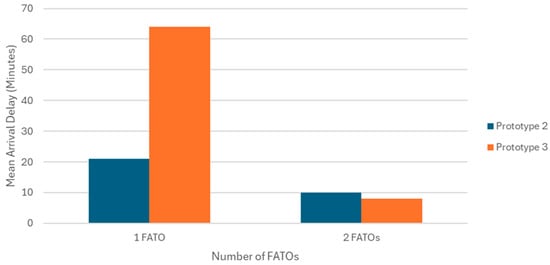
Figure 9.
Mean arrival delay vs. number of FATOs.
There was a significant two-way interaction between the number of FATOs and the number of aircraft, F(1, 6594) = 17.488, p < 0.001, η2 = 0.005. The data indicate that prototype 3 will result in larger arrival delay times when only one FATO is present. When two FATOs are present, the arrival delay time is significantly lower. See Figure 10.
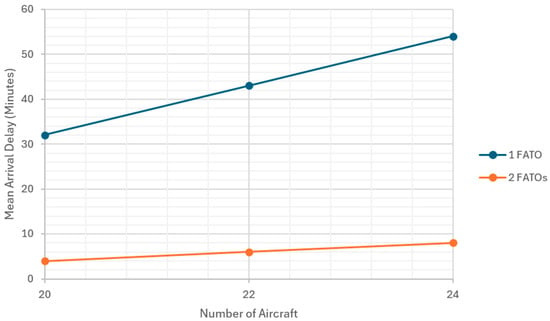
Figure 10.
Mean arrival delay vs. number of aircraft.
5. Discussion
The statistical analysis of the AAM ecosystem revealed some notable trends in the data. First, AAM departure and arrival time delays appear significantly higher when more than 22 aircraft are operating in the AAM ecosystem. In other words, without modifying existing air traffic flow policies and integrating AAM aircraft into proposed corridors, these corridors can accommodate 22 aircraft with no statistically significant operational impact on MCO’s commercial operations and minimal impact on the AAM ecosystem. Over 22 aircraft operations cause the AAM ecosystem to experience statistically significant delays due to AAM traffic separation. Modeling simulations in TAAM revealed that more than 22 aircraft would cause AAM ecosystem traffic to adopt various separation strategies, such as holding patterns (used to position airplanes in a specific location while awaiting further instructions) and speed adjustments to mitigate corridor saturation, significantly increasing AAM delays.
While significant main effects were sound in AAM departure and arrival delays, the two-way interactions in the data highlight some essential key points. The number of FATOs, in this case, two versus one, will significantly reduce AAM departure and arrival delays. This is especially true when AAM aircraft arrivals and departures begin to increase in number. Therefore, it is essential to consider the number of FATOs during the preliminary design of vertiports, particularly considering the anticipated operational tempo during the integration of AAM aircraft. The operational tempo for AAM is expected to increase in different phases, as detailed in the FAA’s operational concept and implementation plans [1,12]. Remarkably, MCO’s operational environment was not directly affected by the AAM ecosystem.
The study’s findings should be viewed in light of various limitations. These findings were derived from a single location (MCO) with particular operational restrictions and parameters. The assessment occurred during the busiest day of the year (2023) in visual meteorological conditions and normal operating settings with no abnormal or emergency scenarios for AAM or commercial traffic. It represented the best-case scenario. However, the findings represent an excellent starting point for future operational considerations, particularly vertiport designs and the number of aircraft or companies expected to operate at this location. Developing a baseline or best-case scenario assessment creates a strong foundation for future exploration in integrating abnormal procedures and emergencies and the impact on existing commercial operations at MCO and the AAM ecosystem.
The future of air transportation depends on effective collaboration among industry leaders, stakeholders, and academic institutions. This collaboration could significantly enhance the assessment of AAM and its operational implications within the NAS. This interdisciplinary approach would promote a more thorough understanding of AAM’s potential impacts, ensuring that strategic decisions are based on different perspectives and viewpoints. The study assessed an AAM ecosystem at MCO based on specific operational assumptions. Based on FAA guidelines and operational concepts, these assumptions must be modified to fit the airport’s operational setting, focusing on achieving the desired operational goals and expectations. Consequently, several research opportunities exist to redefine a future AAM infrastructure at MCO. These opportunities include but are not limited to different vertiport locations on or around airport property, enhancing the developed AAM ecosystem to meet GOAA’s operational needs, incorporating traffic management perspectives, and creating a robust concept of operations.
6. Conclusions
This study analyzed the operational impact of integrating AAM operations at Orlando International Airport’s Class Bravo airspace, emphasizing traffic and wake turbulence conflicts between AAM and MCO traffic. The researchers developed a series of prototypes to evaluate the practicality of AAM corridors in and around Class Bravo airspace and assess the integration’s operational implications. Furthermore, to evaluate the integration using a more realistic approach, researchers developed a what-if AAM ecosystem incorporating AAM traffic and MCO commercial traffic simultaneously. The ecosystem consisted of a series of operational assumptions based on the FAA AAM implementation plans and concepts of operation. The analysis of airspace operations on 25 March 2023 revealed that the proposed AAM corridors did not negatively impact commercial traffic at MCO. Although there were a few traffic conflicts, these could have been managed effectively if the corridors had been in place that day. ATC would have adjusted clearances to prevent these conflicts if they had known about the existence of these corridors.
Integrating AAM into the existing air transportation infrastructure presents opportunities and challenges. This study’s findings underscore the importance of strategic planning and collaboration among industry leaders, stakeholders, and academic institutions. The interdisciplinary approach to assessing AAM’s operational implications within the NAS is vital. By incorporating diverse perspectives and viewpoints, stakeholders can make informed decisions addressing AAM integration’s complexities. Based on FAA guidelines and concepts, the study’s operational assumptions provide a foundation for future research opportunities.
In summary, successfully integrating AAM operations at Orlando International Airport’s Class Bravo airspace requires meticulous planning, collaboration, and continuous evaluation. The suggested AAM corridors demonstrated the potential to operate alongside commercial traffic with minimal disruptions. However, ongoing research and real-world applications are essential to refine the integration process and address unforeseen challenges. By leveraging the insights gained from this study, stakeholders can pave the way for a sustainable and efficient AAM infrastructure that enhances air transportation and meets the evolving needs of the industry.
Author Contributions
Conceptualization, V.F.R.; methodology, V.F.R., R.T., C.C.P., and S.K.; software, C.C.P. and S.K.; validation, V.F.R., R.T., C.C.P., and S.K.; formal analysis, V.F.R., R.T., C.C.P., and S.K.; investigation, V.F.R., R.T., C.C.P., and S.K.; resources, C.C.P.; data curation, R.T., C.C.P., and S.K.; writing—original draft preparation, V.F.R. and R.T.; writing—review and editing, V.F.R., R.T., C.C.P., and S.K.; supervision, V.F.R.; project administration, V.F.R.; funding acquisition, R.T. All authors have read and agreed to the published version of the manuscript.
Funding
This research was funded by the Greater Orlando Aviation Authority (GOAA), contract P.O.97064.
Data Availability Statement
The original contributions presented in the study are included in the article, further inquiries can be directed to the corresponding author.
Acknowledgments
We appreciate the insights and suggestions provided by the GOAA team. Special thanks to Anthony Weatherington, Product Manager and Flight Operations at Boeing Digital Solutions Inc., and Jeppesen for the access and availability of TAAM. We also appreciate the insights provided by Clyde Rinkinen, ERAU College of Aviation, Air Traffic Management.
Conflicts of Interest
The authors declare no conflicts of interest.
References
- Federal Aviation Administration (FAA). Advance Air Mobility Implementation Plan. U.S. Department of Transportation. July 2023. Available online: https://www.faa.gov/sites/faa.gov/files/AAM-I28-Implementation-Plan.pdf (accessed on 1 March 2024).
- Goyal, R.; Reiche, C.; Fernando, C.; Cohen, A. Advanced air mobility: Demand analysis and market potential of the airport shuttle and air taxi markets. Sustainability 2021, 13, 7421. [Google Scholar] [CrossRef]
- Chin, C.; Qin, V.; Gopalakrishnan, K.; Balakrishnan, H. Traffic management protocols for advanced air mobility. Front. Aerosp. Eng. 2023, 2, 1176969. [Google Scholar] [CrossRef]
- Deniz, S.; Wu, Y.; Shi, Y.; Wang, Z. A reinforcement learning approach to vehicle coordination for structured advanced air mobility. Green Energy Intell. Transp. 2024, 3, 100157. [Google Scholar] [CrossRef]
- Bridgelall, R.; White, S.; Tolliver, D. Integrating electric vertical takeoff and landing aircraft into public airspace: A scenario study. Future Transp. 2023, 3, 1029–1045. [Google Scholar] [CrossRef]
- Florida Department of Transportation (FDOT). Report and Recommendations. FDOT Advanced Air Mobility Group. August 2023. Available online: https://fdotwww.blob.core.windows.net/sitefinity/docs/default-source/aviation/pdfs/fdot-aamwg-final-report---august-10-2023.pdf?sfvrsn=56d82d5d_1 (accessed on 1 March 2024).
- Cohen, A.P.; Shaheen, S.A.; Farrar, E.M. Urban air mobility: History, ecosystem, market potential, and challenges. IEEE Trans. Intell. Transp. Syst. 2021, 22, 6074–6087. [Google Scholar] [CrossRef]
- Koumoutsidi, A.; Pagoni, I.; Polydoropoulou, A. A new mobility era: Stakeholders’ insights regarding urban air mobility. Sustainability 2022, 14, 3128. [Google Scholar] [CrossRef]
- Raza, W.; Renkhoff, J.; Ogirimah, O.; Bawa, G.K.; Stansbury, R.S. Advanced Air Mobility: Innovations, Applications, Challenges, and Future Potential. J. Air Transp. 2025, 33, 1–18. [Google Scholar] [CrossRef]
- Silva, C.; Johnson, W.R.; Solis, E.; Patterson, M.D.; Antcliff, K.R. VTOL Urban Air Mobility Concept Vehicles for Technology Development. In Proceedings of the 2018 Aviation Technology, Integration, and Operations Conference, Atlanta, GA, USA, 25–29 June 2018. [Google Scholar] [CrossRef]
- Guo, J.; Chen, L.; Li, L.; Na, X.; Vlacic, L.; Wang, F.-Y. Advanced air mobility: An innovation for future diversified transportation and society. IEEE Trans. Intell. Veh. 2024, 9, 3106–3110. [Google Scholar] [CrossRef]
- Federal Aviation Administration (FAA). Urban Air Mobility Concept of Operations. U.S. Department of Transportation. April 2023. Available online: https://www.faa.gov/sites/faa.gov/files/Urban%20Air%20Mobility%20%28UAM%29%20Concept%20of%20Operations%202.0_1.pdf (accessed on 1 March 2024).
- ElSayed, M.; Mohamed, M. Robust digital-twin airspace discretization and trajectory optimization for autonomous unmanned aerial vehicles. Sci. Rep. 2024, 14, 12506–12530. [Google Scholar] [CrossRef] [PubMed]
- Hu, X.; Pang, B.; Feroskhan, M. Airspace Reconfiguration for Urban Air Mobility: A Spatial—Temporal Analysis of Airspace Availability Within Aerodrome. In Proceedings of the IEEE Conference on Intelligent Transportation Systems, Edmonton, AB, Canada, 24–27 September 2024; pp. 1296–1301. [Google Scholar] [CrossRef]
- Jeppesen. Total Airspace and Airport Modeler (TAAM). Report Number 5526 CA 03_18. Available online: https://ww2.jeppesen.com/wp-content/uploads/2019/02/Airspace-Optimization_TAAM.pdf (accessed on 23 August 2024).
- Greater Orlando Aviation Authority (GOAA). 2023 Strategic Plan. 2023. Available online: https://online.fliphtml5.com/yfqnh/orxj/#p=1 (accessed on 23 August 2024).
Disclaimer/Publisher’s Note: The statements, opinions and data contained in all publications are solely those of the individual author(s) and contributor(s) and not of MDPI and/or the editor(s). MDPI and/or the editor(s) disclaim responsibility for any injury to people or property resulting from any ideas, methods, instructions or products referred to in the content. |
© 2025 by the authors. Licensee MDPI, Basel, Switzerland. This article is an open access article distributed under the terms and conditions of the Creative Commons Attribution (CC BY) license (https://creativecommons.org/licenses/by/4.0/).